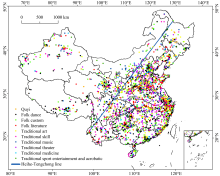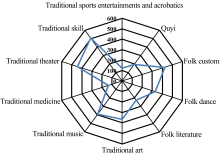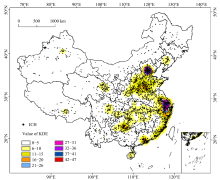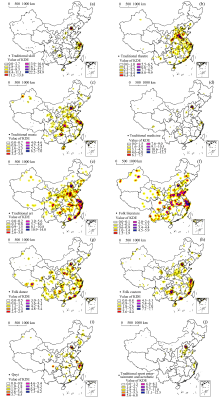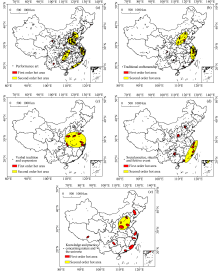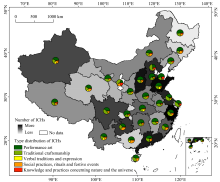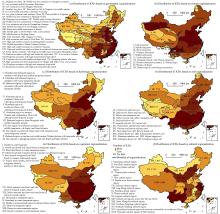Sciences in Cold and Arid Regions ›› 2019, Vol. 11 ›› Issue (5): 389–406.doi: 10.3724/SP.J.1226.2019.00389.
• • 上一篇
Analysis of structural characteristics and spatial distribution of the national intangible cultural heritage in China and its policy implications
- College of Geography and Environmental Science of Northwest Normal University, Lanzhou, Gansu 730070, China
|
Ai L , Lu XS , 2010. Study on protective developing of the Intangible Cultural Heritage resources in grassland ecotourism. Journal of Arid Land Resources and Environment, 4(1): 189-195. DOI: 10.1097/ICO.0b013e3182000add .
doi: 10.1097/ICO.0b013e3182000add |
|
|
Alberto MC , 1995. Cultural routes: Tangible and intangible dimensions of cultural heritage. Inorganic Chemistry, 34(13): 3418-3424. DOI: 10.1021/ic00117a008 .
doi: 10.1021/ic00117a008 |
|
|
Arizpe L , 2004. Intangible cultural heritage, diversity and coherence. Museum International, 56(1-2): 130-136. DOI: 10.1111/j.1350-0775.2004.00467.x .
doi: 10.1111/j.1350-0775.2004.00467.x |
|
| Arizpe L , Amescua C , 2013. Anthropological Perspectives on Intangible Cultural Heritage. In: Brauch HG ed.). Springer-Verlag Press. Berlin, pp. 17-38. | |
|
Barrio MJ , Devesa M , Herrero LC , 2012. Evaluating intangible cultural heritage: The case of cultural festivals. City, Culture and Society, 3(4): 235-244. DOI: 10.1016/j.ccs.2012. 09.002 .
doi: 10.1016/j.ccs.2012. 09.002 |
|
|
Bhakta N , 2015. Visualizing clustering of demographic factors through hot spot analysis in Travis county, Texas. International Journal for Numerical Methods in Engineering, 87(12): 1183-1206. DOI: 10.1002/nme.3154 .
doi: 10.1002/nme.3154 |
|
|
Chen MX , Gong YH , Li Y , et al. , 2016. Population distribution and urbanization on both sides of the Hu Huanyong Line: Answering the Premier's question. Journal of Geographical Sciences, 26(11): 1593-1610. DOI: 10.1007/s11442-016-1346-4 .
doi: 10.1007/s11442-016-1346-4 |
|
|
Cheng Q , Ling SP , 2013. Geographical distribution and affecting factors of the intangible cultural heritage in China. Scientia Geographica Sinica, 33(10): 1166-1172. DOI: 10. 13249/j.cnki.sgs.2013.010.1166 .
doi: 10. 13249/j.cnki.sgs.2013.010.1166 |
|
| China Transportation Atlas , 2016. People's Communications Publishing House, Beijing, pp. 14-32. | |
|
Cominelli F , Greffe X , 2012. Intangible cultural heritage: Safeguarding for creativity. City, Culture and Society, 3(4): 245-250. DOI: 10.1016/j.ccs.2012.10.003 .
doi: 10.1016/j.ccs.2012.10.003 |
|
|
Cozzani G , Pozzi F , Dagnino F , et al. , 2017. Innovative technologies for intangible cultural heritage education and preservation: the case of i-Treasures. Personal & Ubiquitous Computing, 21(2): 1-13. DOI: 10.1007/s00779-016-0991-z .
doi: 10.1007/s00779-016-0991-z |
|
|
Dimitropoulos K , Manitsaris S , Tsalakanidou F , et al. , 2018. A multimodal approach for the safeguarding and transmission of intangible cultural heritage: The case of i-treasures. IEEE Intelligent Systems, 99: 1. DOI: 10.1109/MIS.2018. 111144858 .
doi: 10.1109/MIS.2018. 111144858 |
|
|
Giannis C , Sotiris K , Spiros N , et al. , 2018. A probabilistic, ontological framework for safeguarding the intangible cultural heritage. Journal on Computing and Cultural Heritage, 11(3): 1-29. DOI: 10.1145/3131610 .
doi: 10.1145/3131610 |
|
|
Hashimoto S , Yoshiki S , Saeki R , et al. , 2016. Development and application of traffic accident density estimation models using kernel density estimation. Journal of Traffic & Transportation Engineering, 3(3): 262-270. DOI: 10.1016/j.jtte.2016.01.005 .
doi: 10.1016/j.jtte.2016.01.005 |
|
|
Hughes L , 2011. Preserving the cultural heritage of Africa: crisis or renaissance? .Azania Archaeological Research in Africa, 47(2): 231-233. DOI: 10.1080/0067270X.2012.678651 .
doi: 10.1080/0067270X.2012.678651 |
|
|
Ikemi H , 2017. Geologically constrained changes to geomorphics caused by human activities in the 20th century: A case study from Fukuoka Prefecture, Japan. Applied Geography, 87: 115-126. DOI: 10.1016/j.apgeog.2017.08.001 .
doi: 10.1016/j.apgeog.2017.08.001 |
|
|
Kim S , Whitford M , Arcodia C , 2019. Development of intangible cultural heritage as a sustainable tourism resource: the intangible cultural heritage practitioners' perspectives. Journal of Heritage Tourism, 14(5-6): 422-435. DOI: 10.1080/1743873X.2018.1561703 .
doi: 10.1080/1743873X.2018.1561703 |
|
|
Lenzerini F , 2011. Intangible cultural heritage: the living culture of peoples. European Journal of International Law, 22(1): 101-120. DOI: 10.1093/ejil/chr006 .
doi: 10.1093/ejil/chr006 |
|
|
Liang BE , Ma B . 2008 Research on intangible cultural heritage tourism resources: concept, classification, protection and utilization. Tourism Science, 22(2):7-14. DOI: 10.3969/j.issn.1006-575X.2008.02.002 .
doi: 10.3969/j.issn.1006-575X.2008.02.002 |
|
|
Liu JY , 2013. The study of intangible cultural heritage of Mount Tai from aesthetic anthropology perspective. Mansor MNB (ed.). 2nd International Conference on Science and Social Research. Beijing, pp. 650-654. DOI: 10. 2991/icssr-13.2013.149 .
doi: 10. 2991/icssr-13.2013.149 |
|
| Liu YH , 2015. The study on protection and development of intangible cultural heritage in Laoting. Ph.D diss., Southwest Jiao Tong University, pp. 11-13. | |
|
Lombardo V , Pizzo A , Damiano R , 2016. Safeguarding and accessing drama as intangible cultural heritage. Journal on Computing & Cultural Heritage, 9(1): 1-5. DOI: 10.1145/2812814 .
doi: 10.1145/2812814 |
|
|
Ma SC , Yang HJ , Shi MY , 2018. Utilising Abstraction Techniques and Gaming Theory for Developing Intangible Cultural Heritage. 2018 IEEE 42nd Annual Computer Software and Applications Conference. Tokyo, National Institute of Informatics, pp. 750-755. DOI: 10.1109/COMPSAC.2018.10331 .
doi: 10.1109/COMPSAC.2018.10331 |
|
|
Massing, K , 2017. Safeguarding intangible cultural heritage in an ethnic theme park setting-the case of Binglanggu in Hainan province, China. International Journal of Heritage Studies, 24(1): 1-17. DOI: 10.1080/13527258.2017. 1362571 .
doi: 10.1080/13527258.2017. 1362571 |
|
| Mclaren AE , 2010. Revitalisation of the folk epics of the Lower Yangzi Delta: an example of China's intangible cultural heritage. International Journal of Intangible Heritage, 5(1): 29-43. | |
|
Meskell L , 2015. Transacting UNESCO World Heritage: gifts and exchanges on a global stage. Social Anthropology, 23(1): 3-21. DOI: 10.1111/1469-8676.12100 .
doi: 10.1111/1469-8676.12100 |
|
|
Ott M , Dagnino FM , Pozzi F , 2015. Intangible cultural heritage: Towards collaborative planning of educational interventions. Computers in Human Behavior, 51: 1314-1319. DOI: 10.1016/j.chb.2014.11.039 .
doi: 10.1016/j.chb.2014.11.039 |
|
|
Rees H , Liu ZH , 2017. Intangible cultural heritage in contemporary China: the participation of local communities. International Journal of Heritage Studies, 24(5): 1-3. DOI: 10. 1080/13527258.2017.1413683 .
doi: 10. 1080/13527258.2017.1413683 |
|
|
NIMR Rodzi , Zaki SA , SMHS Subli , 2013. Between tourism and intangible cultural heritage. Procedia-Social and Behavioral Sciences, 85: 411-420. DOI: 10.1111/1469-8676. 12100 .
doi: 10.1111/1469-8676. 12100 |
|
|
Sedita SR , 2012. Leveraging the intangible cultural heritage: Novelty and innovation through exaptation. City Culture & Society, 3(4): 251-259. DOI: 10.1016/j.ccs.2012.11.009 .
doi: 10.1016/j.ccs.2012.11.009 |
|
|
Seegert D , Stefan S , 2013. Intangible cultural heritage in Japan: Bingata, a traditional dyed textile from Okinawa. PhD diss., University College London (University of London), 118(1): A1108-A1109. DOI: 10.1016/j.cag.2011.10.003 .
doi: 10.1016/j.cag.2011.10.003 |
|
|
Steiniger S , Weibel R , 2007. Relations among map objects in cartographic generalization. Cartography & Geographic Information Science, 34(3): 175-197. DOI: 10.1559/15230 4007781697866 .
doi: 10.1559/15230 4007781697866 |
|
|
Tan SK , Tan SH , Kok YS , et al. , 2018. Sense of place and sustainability of intangible cultural heritage-The case of George Town and Melaka. Tourism Management, 67: 376-387. DOI: 10.1016/j.tourman.2018.02.012 .
doi: 10.1016/j.tourman.2018.02.012 |
|
|
UNESCO , 1973. Convention concerning the protection of the world cultural and natural heritage. Museum International, 25(1-2): 452-458. DOI: 10.1111/j.1468-0033.1973.tb02056.x .
doi: 10.1111/j.1468-0033.1973.tb02056.x |
|
| Wang HC , 2010. Chinese Cultural Geography. Central China Normal University Press, Wuhan. pp. 171. | |
| Wang JA , 2004. Atlas of China. In: Zhou Q, Tian Z eds.). Sino Maps Press. Beijing, pp. 17-51. | |
|
Wang Y , Bramwell B , 2012. Heritage protection and tourism development priorities in Hangzhou, China: a political economy and governance perspective. Tourism Management, 33(4): 988-998. DOI: 10.1016/j.tourman.2011.10.010 .
doi: 10.1016/j.tourman.2011.10.010 |
|
|
Wang Y , Hu HL , 2012. Current situation and reflection on the safety of China's intangible cultural heritage. Donyue Tribune, 33(3): 130-138. DOI: 10.3969/j.issn.1003-8353. 2012.03.023 .
doi: 10.3969/j.issn.1003-8353. 2012.03.023 |
|
|
Williams R , 1960. Culture and society. Essays in Criticism, IX. 4: 432-437. DOI: 10.1093/eic/IX.4.432 .
doi: 10.1093/eic/IX.4.432 |
|
|
Yelmi P , 2016. Protecting contemporary cultural soundscapes as intangible cultural heritage: sounds of Istanbul. International Journal of Heritage Studies, 22(4): 302-311. DOI: 10.1080/13527258.2016.1138237 .
doi: 10.1080/13527258.2016.1138237 |
|
|
Yang H , 2018. Analysis of the effect of government incentives on the protection of national intangible cultural heritage: a case study of Ningbo City. Science & Technology Vision, (34): 71-72. DOI: 10.19694/issn2095-2457.2018.34.028 .
doi: 10.19694/issn2095-2457.2018.34.028 |
|
| Zhang N , 2018. Research on the Creation of Intangible Cultural Heritage TV Feature Films—Concurrently Discussing Personal Works "Reverberation of Our Chordal Chamber". M.A. diss. Northwestern University, pp. 1-6. |
| No related articles found! |


